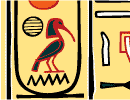Keys to this period
1) Reunification of Egypt!!
2) Renaissance in Egyptian art and the literature.
3) Memphis is the capital once again
4) "Story of Sinuhe" - murder of Amenemhet?!?
Summary
Reunification of Egypt occurred in the 11th Dynasty under the rule of Mentuhotep I, fourth king of that dynasty, whose family was based in Thebes (modern Luxor). After a series of battles with northern rulers, Mentuhotep I controlled the all of Egypt by the 39th year of his reign. The administrative center of the country became a place called Itj-tawy which is believed to have been located near the Faiyum Oasis.
A series of kings oversaw a Renaissance in Egyptian art and the literature of the time reached a high point.
Without one centralized government, the bureaucracy was no longer effective, and regional concerns were openly championed. Egyptian art became more provincial, and no massive mortuary complexes were built. The religion was also democratized, as commoners claimed prerogatives previously reserved for royalty alone. They could, for instance, use spells derived from the royal Pyramid Texts on the walls of their own coffins or tombs.
Reunification
Although the Middle Kingdom is generally dated to include all of the 11th Dynasty, it properly begins with the reunification of the land by Mentuhotep II, who reigned 2061-2010 BC. The early rulers of the dynasty attempted to extend their control from Thebes both northward and southward, but it was left to Mentuhotep to complete the reunification process, sometime after 2047 BC. Mentuhotep ruled for more than 50 years, and despite occasional rebellions, he maintained stability and control over the whole kingdom. He replaced some nomarchs and limited the power of the nomes, which was still considerable. Thebes was his capital, and his mortuary temple at Dayr el-Bahri incorporated both traditional and regional elements; the tomb was separate from the temple, and there was no pyramid.
The reign of the first 12th Dynasty king, Amenemhet I, was peaceful. He established a capital near Memphis and, unlike Mentuhotep, de-emphasized Theban ties in favor of national unity. Nevertheless, the important Theban god Amon was given prominence over other deities. Amenemhet demanded loyalty from the nomes, rebuilt the bureaucracy, and educated a staff of scribes and administrators. The literature was predominantly propaganda designed to reinforce the image of the king as a "good shepherd" rather than as an inaccessible god. During the last ten years of his reign, Amenemhet ruled with his son as co-regent. "The Story of Sinuhe" which was a literary work of the period, implies that the king was assassinated.
Amenemhet's successors continued his programs.
His son, Sesostris I, who reigned 1962-1928 B.C., built fortresses throughout Nubia and established trade with foreign lands. He sent governors to Palestine and Syria and campaigned against the Libyans in the west. Sesostris II, who reigned 1895-1878 B.C., began land reclamation in El-Fayyum. His successor, Sesostris III, who reigned 1878-1843 B.C., had a canal dug at the first cataract of the Nile, formed a standing army (which he used in his campaign against the Nubians), and built new forts on the southern frontier. He divided the administration into three powerful geographic units, each controlled by an official under the vizier, and he no longer recognized provincial nobles. Amenemhet III continued the policies of his predecessors and extended the land reform.
A vigorous renaissance of culture took place under the Theban kings. The architecture, art, and jewelry of the period reveal an extraordinary delicacy of design, and the time was considered the #000000en age of Egyptian literature.
|
|
|





